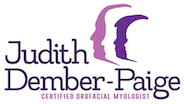[column size=”2-3″]
 Orofacial Myofunctional Therapy
Orofacial Myofunctional Therapy
Orofacial myofunctional therapy identifies, prevents and treats disorders of muscle function of the face and mouth. It restores strength, coordination and motion of the muscles of the face and mouth to optimize complex functions such as chewing, swallowing, and breathing.
Most OMDs originate with insufficient habitual nasal breathing or with oral breathing. The subsequent adaptation of the muscles and the orofacial functions to a disordered breathing pattern creates many OMDs. Orofacial Myofunctional Disorders may impact treatments by orthodontists, dentists, dental hygienists, speech-language pathologists, and other professionals working in the orofacial area.
[/column][column size=”1-3″ last=”1″]Symptoms in Children
- Thumb-sucking
- Drooling
- Tongue Thrust
- A Typical Swallowing
Symptoms in Adults
- Visible Dental Malocclusion
- Dry Mouth from Mouth Breathing
- Sleep Disorder – may be referred for a sleep study
- Clenching/Grinding of Teeth – may have muscle tenderness
[/column]
Correct swallowing depends on a proper relationship between muscles of the face, mouth and throat. The act of swallowing is one function that depends on the body’s vital balance. To swallow properly, muscles and nerves in the tongue, cheeks and throat must work together in harmony. When a person swallows normally, the tip of the tongue presses firmly against the roof of the mouth or hard palate, located slightly behind the front teeth. The tongue acts in concert with all the other muscles involved in swallowing. The hard palate, meanwhile, absorbs the force created by the tongue. In a young child, the deliberate action of the tongue to the palate aids in anterior maxillofacial development. Having a natural lip seal with a tongue resting on the roof of the mouth is a function that is very important for growing children today. If a child persists with an open mouth posture, usually during activities such as watching TV, computer, homework, even sleeping, they may need myofunctional therapy to re-educate the muscles of the face and how the structures work together.
Because a person swallows 500-1000 times a day, improper swallowing can cause a variety of problems. But it is actually the resting position of the tongue that does the most damage because it is more constant.
